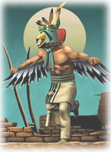|
|||
 Kachina (or Katsina) Kachina (or Katsina)Often called "Kachina Dolls" these Hopi artworks are stylized religious icons, meticulously carved from cottonwood root and painted to represent figures from Hopi mythology. While many other tribes have figure-carving traditions, the Kachina is unique to the Hopi. Kachinas are widely seen and sold in both the Santa Fe and Taos areas. (~Aimee) Kit Carson Home and Museum In 1826, Christopher "Kit" Carson (1809-1868) arrived in Taos, New Mexico. Kit had run away from an apprenticeship in Missouri to join a wagon train heading west on the Santa Fe Trail. Thus began one of the most exciting careers in the American West. Because of his remarkable facility for languages, Carson became a translator for a wagon train to Chihuahua. Shortly thereafter, he became a trapper and mountain man, traveling extensively throughout the West. His real fame grew through serving as scout for the scientific and mapping expeditions of John C. Fremont. From 1854 until 1861, Carson served as an Indian Agent. He then began the final stage of his career as a military officer, first in the Civil War and later in the army campaigns of the Indian Wars. The Kit Carson Home and Museum (which contains part of the original house Kit Carson bought in 1843 for his bride, Maria Josefa Jaramillo) is filled with frontier artifacts and exhibits illustrating Carson's life, as well as other items representing the Native American and Hispanic cultures in Northern New Mexico. The house remained the couple’s permanent home until their deaths in 1868. (~Jean) Kiva Traditionally, a round, underground room used for Southwest Pueblo Indian religious rituals. As cultural changes occurred, kivas became far more elaborate, sometimes containing as many as 90 rooms. They were sometimes built above ground, some were square or keyhole shaped, and some had tower rooms. (~Aimee)  Kiva Fireplace A dome or beehive shaped fireplace made of adobe bricks covered with plaster. The kiva fireplace has an arched opening, and is often built into the corner of a living room, bedroom, or kitchen. They are also found on some outdoor patios. This style of fireplace is commonly found in the authentic adobe-style homes in Taos and Santa Fe. (~Aimee) Kokopelli A kachina found in the mythology of the Southwest Pueblo Indians, Kokopelli plays the part of a fertility god, a trickster, and a hunter. Kokopelli petroglyphs are among the most ancient to survive in Southwest rock art. Also a very popular figure on painted pottery, Kokopelli is depicted as a round-backed figure playing the flute, sometimes carrying a bag on his back, sometimes with antennae resembling an insect, and sometimes with a phallus. (~Aimee) Pictured top to bottom: 1} Hopi Kachina Dancer; 2} Kiva style fireplaces are common in Southwestern adobe homes |
|||
Home | Food | Lodging | Merchants | Services | Real Estate | Art & Galleries | Entertainment | Recreation Ski Areas | Mind-Body-Spirit | Taos Information | Local Color | Taos Pueblo | High Road to Taos | Taos Plaza | Ranchos de Taos Scenic Beauty | Day Trips | Chili | Special Events | Taos History | Multicultures | Museums | The Enchanted Circle The Wild West | Taos Art Colony | Plants & Wildlife | Counterculture | Turquoise | Architecture | Features | About Us | Get Listed! Taos Unlimited Trading Post | Photo of the Week | Link of the Month | Taos Webcams | Taos Weather | Testimonials | Guestbook Taos A to Z | Movie Locations | Sitemap | Taos Unlimited Blog | Aimee & Jean's Story Blog | Contact Us | Santa Fe Unlimited |
|||

